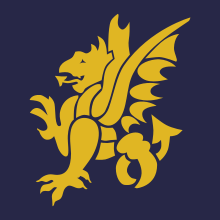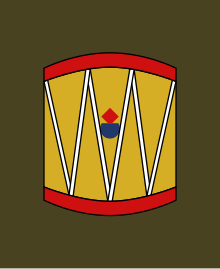43rd (Wessex) Signal Regiment
It had its origins in a Volunteer unit of the Royal Engineers formed in the West Country in 1860 and provided the communications for the 43rd (Wessex) Infantry Division during World War II.
Between 10 and 13 August the division concentrated on Salisbury Plain, with divisional HQ moving from Exeter to Tidworth, to begin war training.
[9][10] On 24 September, at the special request of the Secretary of State for War, Earl Kitchener of Khartoum, the Wessex Division accepted liability for service in British India to relieve the Regular Army units there to go to the Western Front.
[2][3][11][12][13] On 20 November 1914 the 1st Wessex Divisional RE joined 27th Division, which was being assembled mainly from the Regular Army units returning from Indian garrisons.
The front became active again in September 1918 when the Allies began the final offensive and 27th Division was engaged in the capture of the Roche Noire Salient, followed by the passage of the Vardar and pursuit to the Strumica, Valley.
The force was part of the British intervention in the complex situation of independent regimes that had emerged in the Caucasus region following the collapse of the Russian and Ottoman Turkish empires.
It was intended to reinforce the British Expeditionary Force (BEF) in France, but the German invasion of the Low Countries on 10 May ended the 'Phoney War' before the division was ready.
It formed part of the mobile GHQ Reserve disposed on the line from Northampton through North London to Aldershot, from which brigade groups could be despatched to any threatened area.
[25][26][27] By the end of 1940 the division was stationed under XII Corps in East Kent, where it remained for the next four years, first in defensive mode, later training intensively.
It was later noted that its habitual training area round Stone Street, outside Folkestone, bore a marked resemblance to the Bocage countryside in Normandy where it would later fight.
[28][35] Its first action, Operation Epsom starting on 26 June, involved following 15th (Scottish) Division's advance and securing the captured objectives, which included some heavy fighting against a Panzer counter-attack at Cheux.
[28][36][37][38] The division's first major offensive action was Operation Jupiter, to take Hill 112, which had been briefly captured by British armour during 'Epsom' but had to be abandoned.
The attack on 10 July involved bitter fighting and heavy casualties, and was only partially successful, with the hilltop left in No man's land.
[39][40][41][42] At the end of July 21 Army Group was regrouped for the breakout from the Normandy beachhead and after rest 43rd (W) Division moved to XXX Corps to launch an attack on Mont Pinçon (Operation Bluecoat).
It then moved up to Diest to take part in XXX Corps' thrust to link up the bridges seized by airborne forces during Operation Market Garden, beginning on 17 September.
[52][53][54] 43rd (Wessex) Division spent weeks defending XXX Corps' west flank on 'The Island', the low-lying ground between the Waal and Nederrijn.
It was then shifted to the east flank to cooperate with US troops in reducing the Geilenkirchen salient (Operation Clipper), after which the area was defended through winter weather.
[58][59][60] The division then fought through the month-long battle of the Reichswald (Operation Veritable) to capture Kleve, roll up the Siegfried Line defences, cross the Goch escarpment and seize Xanten on the Rhine.
[68][69][70] After a period as occupation forces in XXX Corps' district, 43rd (Wessex) Division's HQ and TA units were demobilised at the war's end.
[29][71] It was regarded as a training and defensive formation and was placed on a lower establishment in December 1941, doing tours of duty in Essex and Northern Ireland.
In addition, each brigade within the division had its own dedicated signal squadron providing Troops to the artillery regiments and rear link detachments to the infantry battalions.



